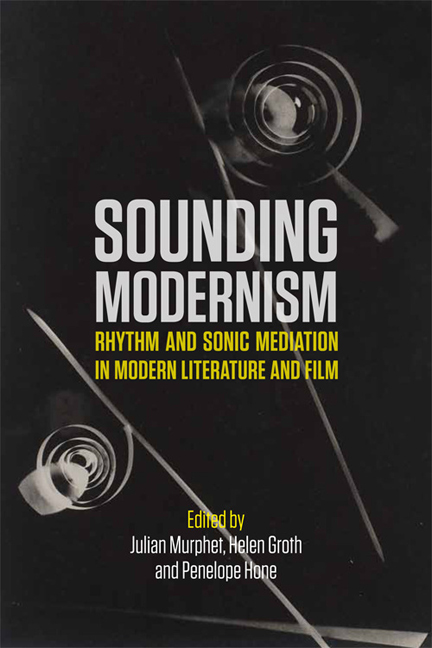Book contents
- Frontmatter
- Contents
- Acknowledgements
- 1 Introduction: Sounding Modernism 1890–1950
- Part One Writing Modern Sound
- Part Two Mediated Voices
- Part Three Difficult Voices
- Part Four Modern Rhythm: Writing, Sound, Cinema
- 12 The Rhythms of Character in Katherine Mansfield's ‘Miss Brill’
- 13 The Rhythm of the Rails: Sound and Locomotion
- 14 Two-step, Nerve-tap, Tanglefoot: Tapdance Typologies in Cinema
- Notes on Contributors
- Bibliography
- Index
14 - Two-step, Nerve-tap, Tanglefoot: Tapdance Typologies in Cinema
from Part Four - Modern Rhythm: Writing, Sound, Cinema
Published online by Cambridge University Press: 22 December 2017
- Frontmatter
- Contents
- Acknowledgements
- 1 Introduction: Sounding Modernism 1890–1950
- Part One Writing Modern Sound
- Part Two Mediated Voices
- Part Three Difficult Voices
- Part Four Modern Rhythm: Writing, Sound, Cinema
- 12 The Rhythms of Character in Katherine Mansfield's ‘Miss Brill’
- 13 The Rhythm of the Rails: Sound and Locomotion
- 14 Two-step, Nerve-tap, Tanglefoot: Tapdance Typologies in Cinema
- Notes on Contributors
- Bibliography
- Index
Summary
Light fantastic
Of the three modes of musical sound production distinguished by musical historians, blowing, scraping and striking, it is the last that has come to the fore in modern music, perhaps in response to a world experienced as never before in the mode of auditory impact and concussion. If one were to think of modern sound as a kind of speech, it would be a matter more of consonants than vowels, of stops more than sustains, of beats more than melodies. Music and dance have responded in many ways to this world of incessant knocks, bumps, jostles, judders, rattles, clicks, cracks, bangs and blips, but nowhere as richly as in the practice of tap dance, which, in the decades before the Second World War, dominated popular music in film. If part of the work of music is to turn raw noise into information by articulating it as pattern, then we might see tap dance as increasing redundance, rendering the random concussions of modern sound purposively percussive.
Historians of dance are agreed that tap originates in a confluence of Northern European rural dance traditions instanced in the Irish and Scottish jig and Northern English clog-dance with African styles of dance retained and developed by slaves in American plantations. Tap retains from both currents the gravitational pull of the ground. Eleanor Powell recounts that, when she first began to learn tap dance, her coach, Jack Donahue, told her ‘“You're … very aerial; in tap you've got to get down to the floor.”’ Donahue came up with a surprisingly direct way of discouraging her balletic levitations:
He had a war surplus belt, the kind that you put bullets in. There weren't any bullets, but on each side of the belt there were two sandbags – the kind they use to weigh down the curtains in a theater. I want you to know that with that belt on I couldn't move off the floor and I haven't moved off the floor since. (x)
- Type
- Chapter
- Information
- Sounding ModernismRhythm and Sonic Mediation in Modern Literature and Film, pp. 211 - 227Publisher: Edinburgh University PressPrint publication year: 2017



